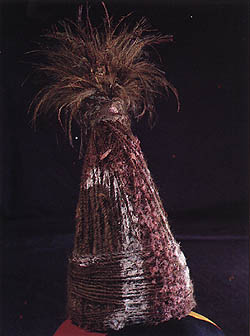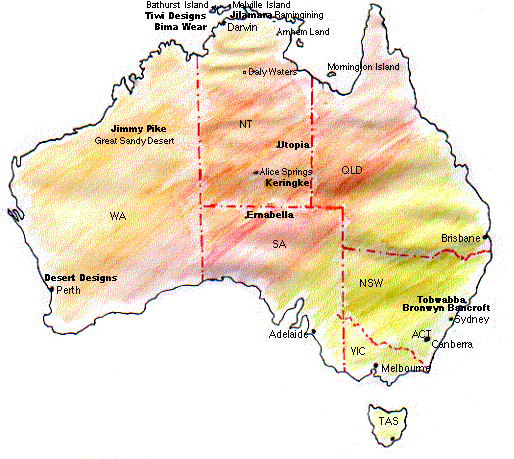|
Aboriginal
and Torres Strait Islanders make a variety of objects
from animal and plant fibres. Their skills in basket
weaving, knotting and utilising animal skins are evidenced
in everyday tools such as baskets for collecting food,
nets for fishing and skin cloaks for warmth. They also
make ceremonial items such as headgear.
While
these traditional crafts are still practised, the arts
and crafts of Aboriginal and Torres Strait Islander
people have expanded to include textile techniques such
as rug making, hand-painting fabrics, screen-printing
and batik, to name just a few.
Arts
and crafts were encouraged on some of the missions.
Ernabella, for example, was established
as a mission station in 1937 by the Presbyterian Church.
Unlike on many other missions "there was to be
no attempt to break down and destroy the traditional
lifestyle, customs or values of the Pitjantjatjara people…"
(Hilliard, 1992: 32). By making available "new
media which, combined with the traditional skills and
art forms of the Pitjantjatjara, were used to produce
works of outstanding beauty." (Hilliard, 1992:
32)
In
the 1970s a system of appointing craft advisers or arts
coordinators was established to foster Aboriginal and
Torres Strait Islander arts and crafts Australia wide.
This system still operates in many communities.
In
1981 the acrylic paintings of the Papunya Tula artists
from Western Desert were shown… The abstractly
coded, and yet personally and socially symbolic dot-and-circle
Aboriginal paintings were received as valid contemporary
international art, and rapidly became sought after
in international exhibitions and Australian and international
collections. (Cochrane, 1992: 326)
This
international acceptance of Aboriginal motifs and designs
allowed the development of a financially viable arts
and crafts industry.
At
the same time as white Australian artists were seeking
to be considered as workers, with the expectation
of some economic viability through their art, Aboriginal
artists over a number of decades had also been adapting
traditional forms and motifs to make objects which,
through sale, would contribute to economic independence.
For many communities art products made for an external
market provided the main source of independent income.
(Cochrane, 1992: 327)
The
eighties saw the expansion of a number of important
economic enterprises where traditional art, often using
new materials, was adapted for an outside market:
- workshops
run by the Tiwi people expanded
the range and quality of their work.
- a
screen-printing and sewing workshop was established
at Jilamara Arts and Crafts at Milikapiti on Melville
Island.
- batik
production expanded at Utopia and
Ernabella in Central Australia
- screen-printing
was introduced to Oenpelli in Arnhem
Land.
- batik,
silk painting and screen-printing were introduced
to Daly River.
Adapted from (Cochrane, 1992: 328)
String bags
String bags are used for the storage and transport of
food and other materials including personal items and
tools. They are also used as sieves in the preparation
of food, for example, when water lily seeds are separated
from their capsules.
These
bags can be distinguished by the type of stitch used
to make them. Some are made with knots, mainly sheet
bends, but not always so; others with looping stitches,
the main varieties being simple loop, loop and twist,
and hour-glass or figure-of-eight. (ATSIC, 1998: 4)

Making a string bag using figure-of-eight
stitches (Photo: A. L. West) |
Activity
Write a list of advantages and disadvantages of using
a string bag.
Baskets
Baskets made by Aboriginal and Torres Strait Islander
artists are of two main types, those made by a weaving
technique and coiled baskets. There are varieties within
each main group.
With
the coiling method, as the name implies, the maker
forms a foundation coil from a bundle of fibres, string
or cane. In indigenous coiled baskets a working
strand of fibre makes a series of button-hole stitches
along the foundation which is shaped into tight coils
or spirals as the work proceeds. Each button-hole
stitch not only encloses a foundation coil but catches
through a button-hole on the coil beneath. Flat or
conical mats can be made in this way, or baskets if
the coils are forced into the vertical as the work
progresses.
This
method of weaving baskets and other fabrics is known
as weft twining. There are two sets of elements, a
warp set made of bundles of fibres or a split cane,
and a weft set usually with two working strands that
interlace with the warps. In some baskets, the makers
occasionally use three-weft strands as a decorative
device. Three-strand twining results in a noticeable
cording effect on the surface of the fabric. (ATSIC,
1998: 4-5)
To
obtain a copy of the ATSIC Fibrecrafts brochure
phone 02 6121 4000.
Pandanus
weaving
The 1992 VicHealth National Craft Award was awarded
to Elizabeth Djuttara from the Ramingining community.
The term used for weaving in this community is buyu.
Buyu-dhamuk means close weave and buyu-gadagada
means open weave.
The
three youngest branches of leaves from the top of
the Gunga (pandanus spirifis) or Screw Palm, are hooked
down by a long stick and the prickly edges stripped
off with the thumbnail. On returning from the bush
the women strip the long leaves into several fibres,
bundle them up and hang them to dry. Weaving may commence
at this stage, and the finished article left white
or decorated with ochres, or the fibres are beautifully
coloured with the natural bush dyes, then woven. (Djuttara,
1992: 34)
|
Ceremonial
items
Not all Aboriginal objects made from or incorporating
fibre are for use in everyday life. Beautifully
crafted, ceremonial fibre objects are still made
and used in northern Australia. These include
sacred strings incorporating colourful parrot
feathers; ceremonial twined baskets decorated
with feathered string and hung with feathered
tassels; and ochred poles, for example Morning
Star dancing poles which are decorated with feathered
string and bunches of feathers. These tall, magnificent
poles are used in mortuary ceremonies. Other ritual
items are shaped from paperbark bound with string
and decorated with ochre to resemble totemic birds
and animals. The costumes and head dresses of
dancers are also mostly made from fibre. (ATSIC,
1998: 9)
In
some areas introduced fibres (for example, strips
of nylon from onion bags) are used in the making
of bags and baskets - though some of the older,
more traditional workers, at least in parts of
Cape York Peninsula, discourage this practice.
European dyes are sometimes used. In central Arnhem
Land a blue-grey colour has appeared in string
and woven objects. Apparently the dye source is
a printers' blue ink obtained by boiling up old
cardboard items with locally gathered fibre. (ATSIC,
1998: 9)
|

Ceremonial head dress worn
by men in circumcision ceremonies on Mornington
Island, Qld. It is made from paperbark and
human-hair string and decorated with emu feathers
and ochres. Photo: courtesy Aboriginal and
Torres Strait Islander Commission.
|
|

Scraping a root of the dye plant
Coelospermum reticulatum (Photo: A. L. West)
|
Animal
skin cloaks
While you may be familiar with the traditional textile
arts of quilting and patchwork you may not be aware
of a similar craft carried out by Aboriginal people
using animal skins. An article about Aboriginal animal
skin cloaks by Fabri Blacklock, Assistant curator, Koori
History and culture, Powerhouse Museum can be found
at: www.amol.org.au/nqr/fabri.htm.
Aboriginal
skin cloaks and skin quilts can also be seen on the
National Quilt Register Tree: http://www.amol.org.au/nqr/tree.asp.
Further information on skin cloaks can be found at:
http://search.museum.vic.gov.au/docpub/documents/10329.pdf.

|